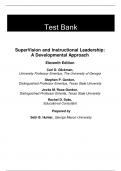Exam (elaborations)
Test Bank For SuperVision and Instructional Leadership A Developmental Approach, 11th Edition by Carl D. Glickman Stephen P. Gordon Jovita Ross-Gordon Rachel Solis
- Module
- Institution
Test Bank For SuperVision and Instructional Leadership A Developmental Approach, 11th Edition by Carl D. Glickman Stephen P. Gordon Jovita Ross-Gordon Rachel Solis
[Show more]



